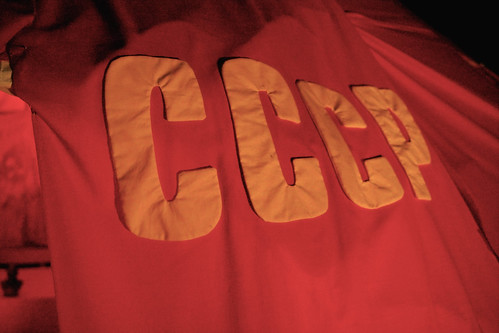
‘Soviet Unterzoegersdorf’
courtesy of ‘boklm’
In 1993, former KGB officer Alexander Vassiliev was permitted unique access to Stalin-era records of Soviet intelligence operations against the United States. Vassiliev subsequently shared the notes he took with Library of Congress historian John Earl Haynes and Emory University professor Harvey Klehr. Together they have written an extraordinarily detailed and shocking account of the KGB’s espionage successes in America, including penetrations of American government and industry at the highest levels. The authors expose Soviet spy tactics and techniques and shed new light on many controversial issues, including Alger Hiss’s cooperation with Soviet intelligence, KGB recruitment of muckraking journalist I.F. Stone, and Ernest Hemingway’s meetings with KGB agents. Join John Earl Haynes and Harvey Klehr, authors of Spies: The Rise and Fall of the KGB in America, at a special free lunchtime chat and booksigning event at the International Spy Museum on Thursday, August 20 from noon to 1 p.m. (No tickets required.)
A special Q&A with the authors after the jump.
Q: At one time, your work on Venona led to the identification of approximately 350 Americans having a “covert relationship” with the Soviet Union and that only half of which were ever identified. Have those number shifted significantly over the years?
The KGB documents recorded in Alexander Vassiliev’s notebooks provides real names for 72 of the cover names in the deciphered Venona cables which the FBI could not connect to a real person. However, the notebooks also refer to several dozen other Soviet intelligence contacts in the U.S. where only a cover name is given and no real name provided. So, the number of unidentified is down considerably, by about 50, but a significant number remain.
Q: What in your opinion was the single greatest success of Soviet Intelligence within the US?
Easily the greatest success for Soviet intelligence was its atomic espionage. In developed a number of excellent sources in both the American and the partner British atomic program. In the U.S. the most important sources were Klaus Fuchs and Theodore Hall at Los Alamos with lesser but still significant sources being Russell McNutt and George Koval at Oak Ridge and David Greenglass at Los Alamos. In Britain the KGB developed two excellent sources, Melita Norwood and the physicist Engelbert Broda. And Fuchs was first recruited in Britain and continued to spy for the USSR after he returned to Britain from his assignment at Los Alamos.
Q: Debates still rage over figures such as Oppenheimer or I.F. Stone being spies? Where do you draw the line from conversation to complicity? And were they?
Oppenheimer was a leading target of KGB recruitment starting in 1942 because of his secret membership in the Communist Party. But the KGB never succeeded in even contacting him. It was not until late 1945 that the KGB believed the information from several of its sources who knew Oppenheimer that he had not only dropped out of the Communist Party in 1942 but by 1945 was strongly advocating American atomic policies that were incompatible with Soviet goals. By 1950 Oppenheimer was on a roster of “leading reactionary scientists” to be discredited in a KGB disinformation campaign.
As for Stone, the Vassiliev notebooks show that he was recruited in 1936 and assisted the KGB until late 1938 and perhaps into 1939 but then sometime in 1939 the connection was broken. The KGB attempted to re-recruit him in late 1944 but the evidence is unclear on whether this re-recruitment was successful. As a journalist (and a young one in the 1930s, Stone had no access to government or technical secrets. But the KGB like to recruit journalists to undertake other espionage tasks, tasks that are essential for a successful spying operation but not particularly glamorous. Stone worked as a courier linking professional Soviet KGB officers to American sources and assisted in identifying and recruiting sources.
Q: What still remains the biggest mystery?
The biggest mystery are the operations of the GRU, Soviet military intelligence. With by late 1930s and 1940s, the KGB was the largest Soviet foreign intelligence agency, GRU’s operations remained significant. We know far more about KGB operation in the United States because of several key KGB defectors (notably Elizabeth Bentley) and the accident that most of the deciphered Venona cables were KGB and only a few were GRU. And Vassiliev’s notebooks are drawn only from the KGB’s archive. Of GRU, we know very little. George Koval, for example, was a GRU agent who penetrated the Manhattan atomic Project, but we know of him only because the Russian government decided to public give him a posthumous medal for his atomic spying.



